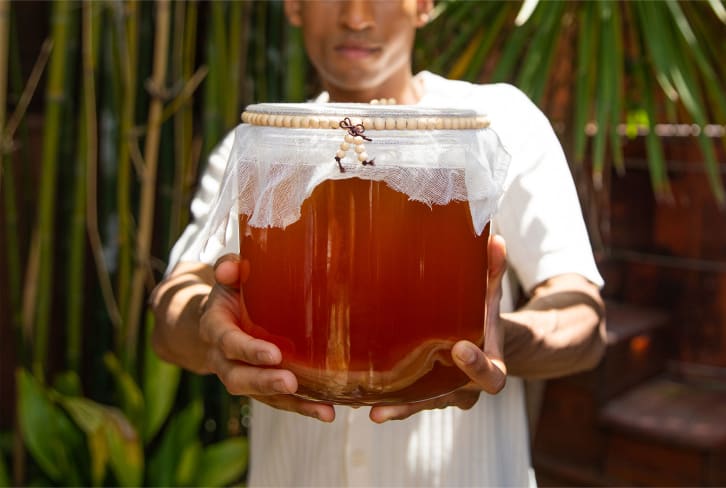Advertisement
5 Superb South American Spices To Promote Digestive Health


At mindbodygreen, a healthy microbiome is essential. This dynamic ecosystem plays a substantial role in maintaining the bodies' daily operations—from stimulating the immune system1 to fighting inflammation. So, how do you keep the gut healthy? The usual suspects are a good starting place (eating a plant-rich diet, moving every day, managing stress, etc.), but sometimes you need a little extra support. That's where South America's nutrient-dense herbs and spices come in.
South America's well-established herbal traditions lean on the antioxidant, anti-inflammatory, and antimicrobial properties of various plants, as have many other cultures since ancient times. Drawing from my experience as a health coach, I've rounded up five of my favorite gut-supporting South American spices and herbs, to upgrade your current spice rack and encourage digestive strength:
Cedron (Aloysia citriodora)
Also known as lemon verbena, herb luisa, or lemon beebrush, cedron is a small flowering plant with robust mint and lime scents from the Verbenaceae family. It is traditionally used in home remedies to relieve indigestion, reduce abdominal swelling, reduce stomach spasms, and soothe IBS-related symptoms.
However, it's important for me to note these potential benefits are based on anecdotal claims—while there is some research on its digestive benefits for rats2, more research is necessary to determine cedron's effect on the human body.
Muña Muña (Minthostachys mollis)
With origins in the Andes, muña muña's unique minty flavor has made it a popular flavor-booster in multiple South American dishes and medicinal herbal brews. Among the plant's 19 composites, its phenolic compounds3 (and their bioactive function) are thought to help the digestive process work more efficiently overall.
Milenrama (Achillea millefolium)
Although milenrama (from the Asteraceae family, often called "yarrow") isn't native to South America, its remedial and culinary applications have been used throughout the region for centuries. Also known as plumajillo (New Mexico) or sweet oregano (Ecuador), according to traditional medicinal accounts4, milenrama may help alleviate menstrual cramps, indigestion, and diarrhea.
While there is limited research on humans, animal studies suggest that the flavonoid antioxidants in milenrama/yarrow tea may help reduce gastrointestinal spasms5 and inflammation.
In Peruvian medicinal practices, its leaves are also applied topically to ease hemorrhoids, and speed up the wound healing process.
Boldo (Peumus boldus)
Endemic to Chile's central region, this tree is considered a powerful plant with multiple health-related applications. According to anecdotal reports, its leaves and bark are traditionally used topically or orally6 (as a tincture, tea, or syrup) to treat kidney disease, indigestion, fluid retention metabolic imbalances.
Still, studies supporting boldo tea as a digestive, liver, or kidney remedy are lacking, and we still need further research to confirm its potential health benefits.
Paico (Dysphania ambrosioides)
Paico is a perennial herb native to Southern Mexico, Central America, and South America, mainly used as an antiparasitic treatment. Known to the Aztecs as epazotl, in folk medicine, paico is traditionally used to treat digestive disorders7, pneumonia, hemorrhoids, gastritis, dysmenorrhea, and urinary tract inflammation, among others.
Although it's common to add paico leaves to fava-based stews, homemade broths, or tamales—in countries such as Bolivia, Colombia, and Ecuador—paico leaves are generally reserved (in moderate doses) for hot herbal teas. Despite paico's extensive use across Latin America, more research is necessary before confirming its efficacy and safety.
You can find most of these traditional herbs and spices in Latin American markets across the country. However, make sure to consult your primary health care provider before introducing any dietary modifications that might affect your health and well-being.
7 Sources
- https://www.nature.com/articles/nature10213
- https://pubmed.ncbi.nlm.nih.gov/24513110/
- https://www.sciencedirect.com/science/article/abs/pii/S0308814611004948
- https://www.ncbi.nlm.nih.gov/pmc/articles/PMC3847392/
- https://pubmed.ncbi.nlm.nih.gov/17009839/
- https://pubmed.ncbi.nlm.nih.gov/31466647/
- https://www.sciencedirect.com/science/article/abs/pii/S0378874113003310
Watch Next
Enjoy some of our favorite clips from classes
Enjoy some of our favorite clips from classes
What Is Meditation?
Mindfulness/Spirituality | Light Watkins
Box Breathing
Mindfulness/Spirituality | Gwen Dittmar
What Breathwork Can Address
Mindfulness/Spirituality | Gwen Dittmar
The 8 Limbs of Yoga - What is Asana?
Yoga | Caley Alyssa
Two Standing Postures to Open Up Tight Hips
Yoga | Caley Alyssa
How Plants Can Optimize Athletic Performance
Nutrition | Rich Roll
What to Eat Before a Workout
Nutrition | Rich Roll
How Ayurveda Helps Us Navigate Modern Life
Nutrition | Sahara Rose
Messages About Love & Relationships
Love & Relationships | Esther Perel
Love Languages
Love & Relationships | Esther Perel
What Is Meditation?
Box Breathing
What Breathwork Can Address
The 8 Limbs of Yoga - What is Asana?
Two Standing Postures to Open Up Tight Hips
How Plants Can Optimize Athletic Performance
What to Eat Before a Workout
How Ayurveda Helps Us Navigate Modern Life
Messages About Love & Relationships
Love Languages
Advertisement

How To Use Food To Recover From Autoimmunity: An MD's Top 4 Tips
Sara Szal Gottfried, M.D.











